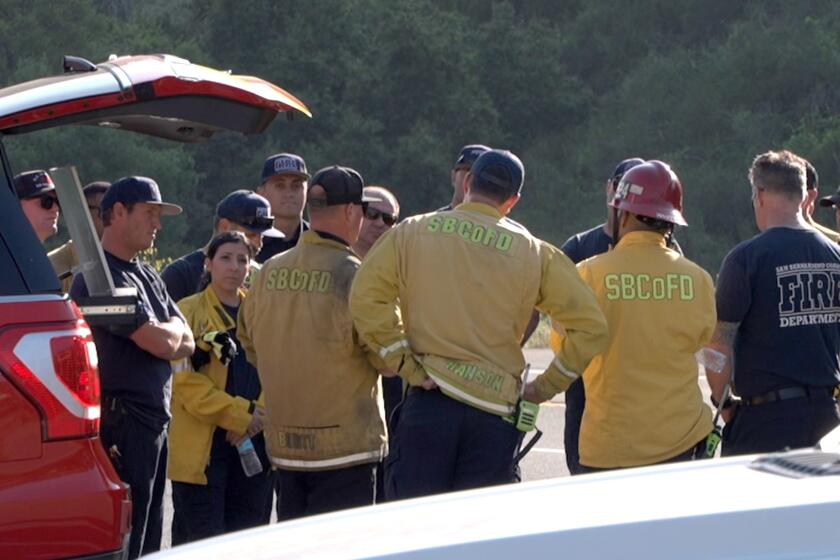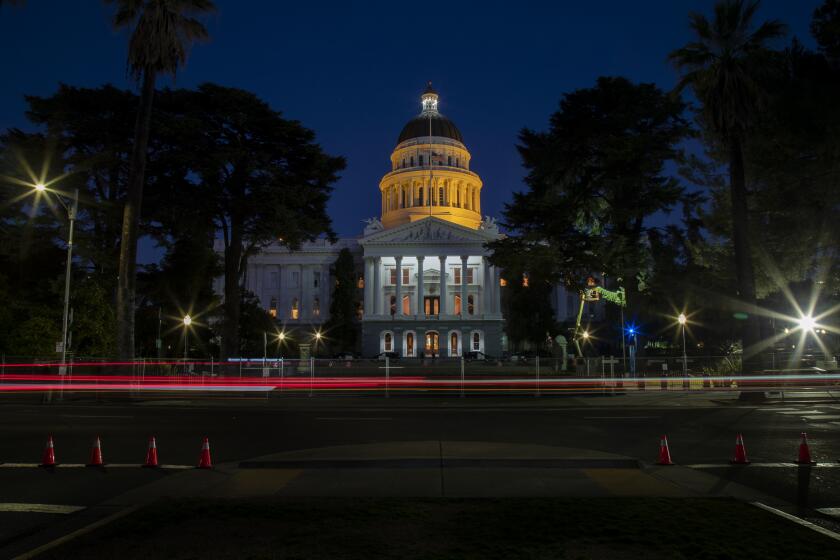A Natural Development : Wildlife Habitat Is Being Created to Replace One Being Lost
Municipal officials, highway builders and developers Wednesday unveiled a newly constructed nature reserve near Hollins Lake that is designed to replace an area that will be destroyed when California 52 is extended from Tierrasanta eastward to California 67.
The $7-million Caltrans highway mitigation project on the banks of the San Diego River is the most comprehensive ever attempted in California, according to Caltrans officials. The tract is intended to serve as a nesting and grazing area for the least Bell’s vireo, a songbird on the federal endangered species list.
More than 10% of the 300 to 400 pairs of vireos in the U.S. are believed to nest along the San Diego River each spring when they migrate north from Mexico.
Construction crews cleared the way for the new habitat by bulldozing 700,000 cubic yards of earth. Crews are now completing the planting and transplanting of more than 125,000 native plants, trees and bushes that, officials hope, will transform the area into a riparian habitat. On Wednesday, crews had marked the location of those plantings with more than 120,000 yellow, red and blue flags.
Although planting at the reserve will be completed in June, it will take years for the cottonwoods and willows to mature and for ground cover to become established. Consequently, naturalists must wait to learn if the project that straddles the San Diego-Santee border will attract any of the endangered birds.
Environmentalists and government officials have battled for more than three years over the highway extension that would cut through one of the endangered songbird’s few remaining habitats in San Diego County. The 10-mile stretch of four-lane highway, which would traverse the northern boundary of Mission Trails Park, eventually will reduce traffic on Interstate 8 by about 270,000 cars daily, according to the San Diego Assn. of Governments.
The mitigation project was mandated in a habitat conservation plan adopted by Sandag. Construction on the highway segment on the reserve’s eastern boundary is prohibited until naturalists determine that the newly planted trees, bushes and plants are mature enough to serve as home to birds normally found in riparian habitats, said Sandag Senior Planner Mike McLaughlin.
Environmentalists and naturalists, who were conspicuously absent from the press conference, Wednesday praised Caltrans for the design and construction of the 45-acre parcel that sits on both banks of the San Diego River near Hollins Lake. Caltrans has “done everything they possibly could to bring about success,” said Emily Durbin, a Sierra Club spokeswoman. “If nature cooperates, it will work.”
“But the jury is still out,” Durbin said. “We’d prefer to wait until the area is populated with vireos before” labeling the project a success, Durbin said. The Sierra Club and the Audubon Society also have doubt about the countywide habitat conservation plan that Sandag created to protect the vireo and other sensitive wetlands species, Durbin said.
Government representatives at Wednesday’s press conference praised the mitigation project as proof that development and nature can occur side by side without adverse effects. “This is one of the best examples of how highway and habitat have to work together,” said Sandag Executive Director Ken Sulzer.
“The best form of flattery is to imitate, and we have tried to imitate Mother Nature,” said Caltrans District 11 Director Jesus Garcia.
“It’s been a fight all the way for Route 52,” acknowledged San Diego Councilwoman Judy McCarty, who has been a prime sponsor of the highway project and the development of the Mission Trails park. “Highway 52 is absolutely vital to (San Diego’s) 7th District and to the East County. But we love the park, and 52 will help provide access into the park so people can use it.”
“This is exactly the kind of density we like to see in Santee--2,700 trees to the acre,” quipped Santee Mayor Jack Doyle, who along with El Cajon Mayor John Reber described California 52 as vital to the East County’s economy.
Construction of the 10-mile California 52 extension is scheduled to begin in the summer of 1991, and completion of the first segment is scheduled for late 1993. That 7-mile stretch will cost an estimated $120 million to build, including $20 million for acquisition of right of way. The final route of California 52 was altered to minimize the impact on the least Bell’s vireo habitat and several vernal, or seasonal, pools.
The mitigation project includes 11.5 acres on the south bank of the San Diego River and about 34 acres on the north bank. Caltrans, in September, 1989, awarded a $7-million contract to Smith & Reynolds Erosion Control, which will complete work on the project in June.
More to Read
Start your day right
Sign up for Essential California for news, features and recommendations from the L.A. Times and beyond in your inbox six days a week.
You may occasionally receive promotional content from the Los Angeles Times.






